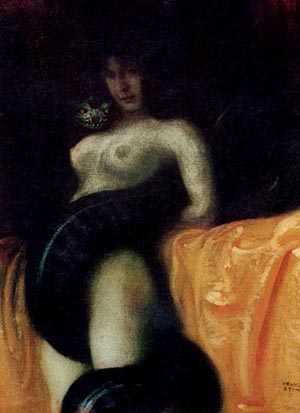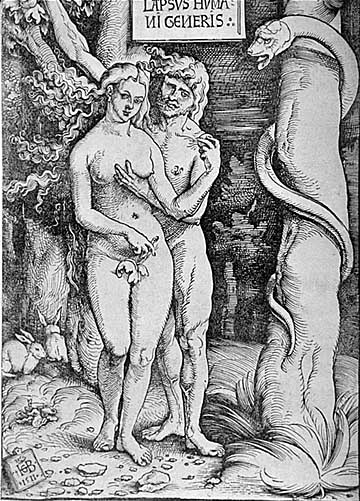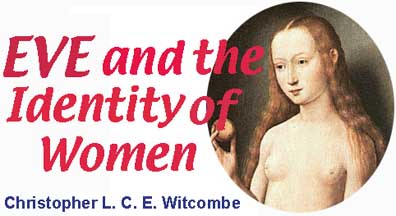|
||||
|---|---|---|---|---|

Eye Body
|
Serpents
The ancient cult of the Mother Goddess as manifest in Canaan in the popular Baal/Asherah cult was one that the Yahwists were most intent on suppressing. The transformation in Genesis 3 of the Goddess's wise serpent into a creature feared and despised has been described as one of the more successful campaigns perpetrated against the older cult.
These days the serpent is regarded as one of the chief symbols of the Mother Goddess and attempts have been made to reclaim it as a creature of significance to women.
In the English language a distinction can be made between "snakes" on the one hand and "serpents" on the other. "Snake" is a native English word commonly used to describe the zoological creature. The word "serpent", however, sounds more alien and is usually reserved for large or venomous specimens.
One lexicographer observed that snakes are insidious, cold and contemptible, while serpents are terrible, powerful, and beautiful. The term serpent also opens up enormous metaphorical possibilities. The relationship of snake to serpent is not unlike that of penis to phallus.
The serpent has symbolised many different ideas. One of the earliest and most fundamental, derived from solar mythology, is lightning and the storm-cloud. Lightning is snake-like both in its form and in the speed with which it strikes.
It was also associated with storms and rain. Baal, who was represented as a serpent, was a storm god who fertilized the earth with rain. At the same time, however, the serpent was seen as an earth-dwelling creature and so regarded as autochthonous and the natural guardian of earth's treasures.
Over time, the serpent has also been associated with life, longevity, ancestry, generation, health, healing, and immortality. Many cultures regard the serpent as wise and clever. In the story of Eve, however, this wisdom is twisted into a devious form of cleverness described as "cunning". The term is related to the female genitals (as the modern slang term makes clear), and refers to the site, or source, of women's learning, insight, wisdom and knowledge (literally "carnal knowledge").
The serpent has been connected in one way or another with both the female and the male sex. Its association with women would appear to be through its sinuous, curving, sensuous body, and through its ability to fascinate with its eyes.
Its association with men would seem to lie primarily in its phallic form; long before the Freudian 20th-century, the serpent was seen as a symbol of the male penis.
In the ancient world, for example, Plutarch reports the legend that Alexander the Great was fathered by a snake that his presumptive father, Philip of Macedonia, had seen in bed with his wife Olympias.
Similarly, Suetonius, records that Octavius, later Emperor Augustus, was believed to have been divinely conceived after his mother, Atia, had been penetrated by a snake that mysteriously appeared while she dozed at a midnight service at the Temple of Apollo.

Sensuality
The image of the serpent as phallus is left in little doubt in the painting Sensuality by Franz Von Stuck (1863-1928) that shows an enormous python-like creature passing provocatively between the legs of a seductively posed nude woman. The serpent's head rests on the woman's right shoulder; both the serpent and the woman look out at the (male) viewer combining in their gazes a lethal mixture of seduction and destruction. The serpent/penis association certainly adds a sexual twist to the Genesis narrative, with Eve tempted and seduced as much by the (Adam's) snake-penis as by the promise of the fruits of the tree of knowledge. If Eve was tempted by Adam's "serpent" (see, for example, Michelangelo's Temptation and Fall on the Sistine Chapel ceiling) then Adam was seduced by Eve's "apple." Although Genesis makes no mention of what sort of fruit Eve plucked from the Tree of Knowledge, tradition has long identified it as an apple. It is but a short Freudian step to identify the apple with Eve's breast.

Fall of Man
A chiaroscuro woodcut dated 1511 by Hans Baldung Grien of the Fall of Man, which shows Adam holding Eve's left breast, clearly illustrates this association between breast and apple.
An earlier version of this essay appeared originally in Images of Women in Ancient Art
Copyright © (text only) 2000. Christopher L.C.E. Witcombe
|
|||

